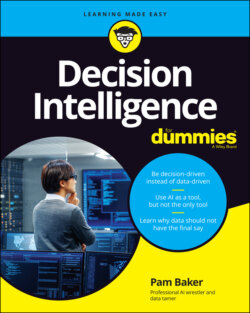Читать книгу Decision Intelligence For Dummies - Pamela Baker - Страница 37
Experiencing the epiphany
ОглавлениеTo date, we humans have all been mining data to sort information into useful pointers — pointers to which products customers might want to buy now or next and which price they might be willing to pay, for example, or pointers on who on the team might have an edge to help win a baseball game or reach a sales quota, or even pointers on which activities might indicate the beginning of a data breach and which are the routine work behaviors of hundreds of staffers now working from home during a pandemic.
Pointers of all kinds — here, there and everywhere. And there’s nothing wrong with any of this. Pointers can, and often do, direct people to a path forward in business, at home, and in various other endeavors.
However, pointers mark a path (often, one among many), but they don’t decide which path you should take. In other words, pointers aren’t the same thing as decisions. You’re free to make the wrong choice as much as you’re free to make the right one. But that approach falls woefully short of the tall promise in data driven decisions, doesn’t it?
“Following the data” was supposed to render some infallible truths and reliable actions. That’s why so many analytics vendors tout actionable outcomes or actionable outputs. Short of automating that action, however, even recommended actions are pointers as well.
For example, predictive analytics might produce an actionable outcome, saying that a part in a machine will last ten more days and should be replaced on the ninth day. This action gets the most use out of that part with no interruption in the machine’s performance. However, a decision still needs to be made. Company leaders may decide to order maintenance crews to follow all such directives and replace parts on the days indicated. Or, management may ignore the directive in favor of upgrading or replacing the machine instead.
That’s okay for as far as it goes. But you need more from data analytics if the aim is to make correct or best decisions of a more complex and demanding nature — especially if they are grave decisions that can carry serious consequences.
For example, take a hard look at the COVID-19 pandemic and the many survival questions that sprang forth from it. Data and analytics can tell us how the virus spread, which virus variations exist, and who was most at risk. This was and is important information. However, data and advanced analytics — even the much-ballyhooed AI — cannot tell us whether it’s safe to send children back to school. The information also shed no light on when, where, or how to safely return people to workspaces or to indoor dining and entertainment venues to help save the economy. In turn, leading public health authorities such as Dr. Fauci and others were unsure which actions to recommend.
In other words, all the data and all the analytics could not tell people what we most needed to know. And this is the recurring lesson that taught some data scientists to look for another way — perhaps by evolving current methods in analyzing data — so that outputs would consist of decisions and not mere information. In the wake of recognizing that today’s data idol has feet of clay, we have come to this powerful epiphany:
Information is useful, but knowledge is power.
If you’re thinking that we humans are rediscovering an epiphany first perceived many years ago, you are correct. Similarly, decision intelligence is not a new idea but rather a renewed one.
